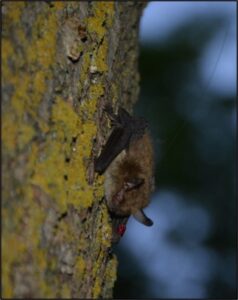Some species of greatest conservation need (SGCN) in Wisconsin require a forested landscape diverse in structure, composition, function and complexity. Both young forests with particular habitat characteristics and old forests with more complex structures and species composition are necessary to meet the life cycle and habitat needs of SGCN species. This allows those species to grow and maintain their populations into the future.

A roosting bat. Credit: Wisconsin DNR
Younger forests provide dense groundcover, decaying coarse wood and brushy openings adjacent to mature stands necessary for SGCN species like the woodland jumping mouse and Golden-winged Warbler. Older stands provide complex structures, including large trees, standing dead trees and trees with cavities and cracks that serve as nest sites for forest raptors and roosting sites for declining forest bat species. Stands with mixed coniferous trees in the understory and overstory are important habitat for SGCN species like Swainson’s Thrush and Evening Grosbeak.
An important goal of the 2020 Statewide Forest Action Plan, critical for SGCN populations, is to maintain and enhance the diverse structure, species composition, function and complexity of Wisconsin’s forested landscape.
